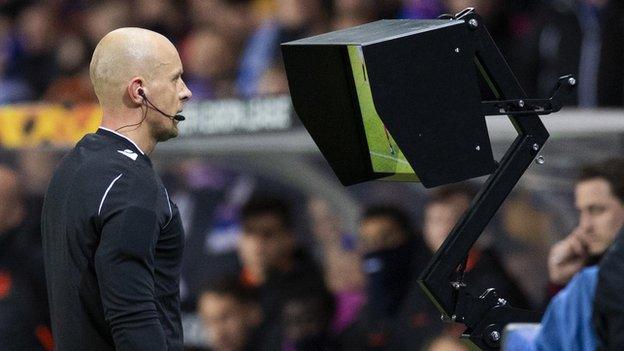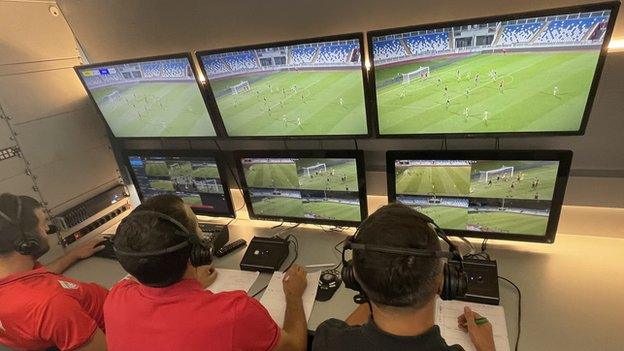VAR in Scotland: Key questions answered as club meeting looms
- Published

VAR has been used at Scottish grounds for Uefa competitions but never for domestic football
What do Kosovo, Morocco and Thailand all have in common? Each of their top-flight football leagues have video assistant referees (VAR) while Scotland's does not.
This Friday, the Scottish FA and SPFL will host a video conference with Scottish Premiership clubs to discuss the technology's introduction for all top-tier games and the latter rounds of domestic cup competitions.
But why has it taken so long to get here? How would it work? Who would pay for it? And will clubs be in favour?
Wait… what is VAR?
If this section applies to you, it would be safe to assume you are either not the biggest football fan or have been living under a rock for the last three years.
With the way the world has been recently, no one would blame you if you fall into the latter category, but the introduction of VAR to football in 2018 has been the single biggest change to the game in modern times.
The intention is to give officials more support with on-field decisions, as an extra assistant referee is able to review "clear and obvious errors" via video replay.
These reviews can only take place in the event of a goal, penalty decision, red card incident or mistaken identity. Yes, that means Italy's goal at Hampden in 2007 would still stand - free-kick decisions in the lead-up to goals do not get reviewed.
Why do we not have it in Scotland?
While VAR has been introduced to the game's top leagues and competitions around the world, it is also in use in divisions with fewer resources - like the aforementioned Kosovan, Moroccan and Thai top flights.
You can add Ukraine, Slovakia and Israel to that list - three divisions that are below Scotland in Uefa's coefficient ranking - so why is the Premiership yet to have the technology?
In March last year, SPFL chief executive Neil Doncaster told The Price of Football podcast, external he feared VAR would damage the league's brand and voiced concerns about financial implications.
"Our brand is about in-stadium passion, drama and excitement," Doncaster said. "If you end up in a situation where people don't feel they can celebrate a goal properly in case it's chalked off, you damage what Scottish football's all about.
"If it can't be made to work with all of the millions in the big five leagues, then you should be very careful before there's implementation in Scotland."
So, what's changed?
The two main factors appear to be a drop in cost and the fact there has been a "meaningful bedding-in period" elsewhere.
The Euro 2020 finals - during which Hampden hosted four games - highlighted how the technology can be used more seamlessly, and adaptations to its implementation south of the border have hushed a lot of the criticism.
"VAR is here to stay and in a short period its implementation has advanced significantly," said Scottish FA chief executive Ian Maxwell last week.
"Its set-up and maintenance costs have reduced. We are now at the point where we need to discuss and ideally agree on its introduction into Scottish football."
Doncaster added that now is "a good time to look again at the benefits" of VAR.
How will it be implemented?
One thing for certain is more cameras will be required, as non-televised Scottish Premiership games only currently use four.
In Kosovo's top division - a league which features 10 teams and five fixtures per week - there are six cameras installed at every stadium, while a van also travels to each game.
So not only will Scottish grounds require additional cameras, but VAR hubs and pitchside monitors will have to be arranged.
Premiership referees will also have to go through training. As it stands, only three Scottish officials can boast a shiny completion certificate, so their colleagues can expect a rigorous course if the technology is introduced.
Visar Kastrati, Fifa referee and Kosovo's head of VAR education, told BBC Scotland his nation's officials required six months of "constant" training, but all costs for the implementation were covered by their football federation.

For every top-flight game in Kosovo, a VAR official, assistant VAR official & replay operator watches from their hub
"Kosovo has been very quick on implementing VAR," he says. "But it has been a very tight schedule and very intensive work.
"Even though the Fifa plan requests 18 to 24 months to complete the steps, we managed to finish everything in record time with a lot of effort and stubbornness."
All this preparation means it is expected that should VAR come into the Scottish game, it will not feature in the top flight until the 2023-24 campaign.
Will clubs be in favour?
VAR is still causing some division among fans, but the general feeling within Premiership clubs is for change.
Hearts chief executive Andrew McKinlay told Sportsound that Scottish football is in danger of becoming "backwater" without VAR, while Tynecastle boss Robbie Neilson said "it would take the league forward".
Motherwell manager Graham Alexander echoed those opinions, saying it is "100% worth doing" if the technology is "managed right".
And while Livingston counterpart David Martindale questioned whether his club could afford it, he insisted it has to be introduced to "help the officials out".
Who will pay for it?
While there appears to be uniform backing, there are questions around funding. The Scottish FA is prepared to underwrite training costs, but it is expected that Premiership clubs will have to stump up a combined £1m.
That could amount to around £80,000 per year for each of the 12 sides - not far off the average player's yearly salary.
Also, with the technology expected to be implemented in the latter rounds of cup competitions, it remains to be seen whether payments will be required from lower-league outfits.